Glory, Grace and Truth
John 1:14-18
John 1:14-18
1. Dwelt (verse 14)
2. Glory (verses 14-15)
3. Grace (verses 16-17)
4. Truth (verses 17-18)
I want to begin this morning by telling you about a little booklet entitled, "The Stories of the Gospel of John," by Tom Lach. It’s 60 pages long, and mostly filled with pictures. These pictures in the booklet are pictures of the stories of the gospel of John, linked to the chapters in which they occur. They are super-helpful to understanding the book of John. So, this morning, as a long introduction, I want to help all of us with understanding the book of John, by working through the pictures in this book.

The first picture is the number, 1. It stands for chapter 1. The picture that goes along with it has a hand with the index finger pointed in the air. This is often the sign for “number 1.” This reminds us of the first things written, going back to the creation of the world, with the moon and the stars (and the waves). Also, in the lower right-hand portion of the “1” is John the Baptist in the Jordan River baptizing someone. The picture is a helpful reminder to us of what happened in chapter 1. As Jesus, the one who created all things came into the flesh to walk among us. Also included in the chapter is some description of John the Baptist.
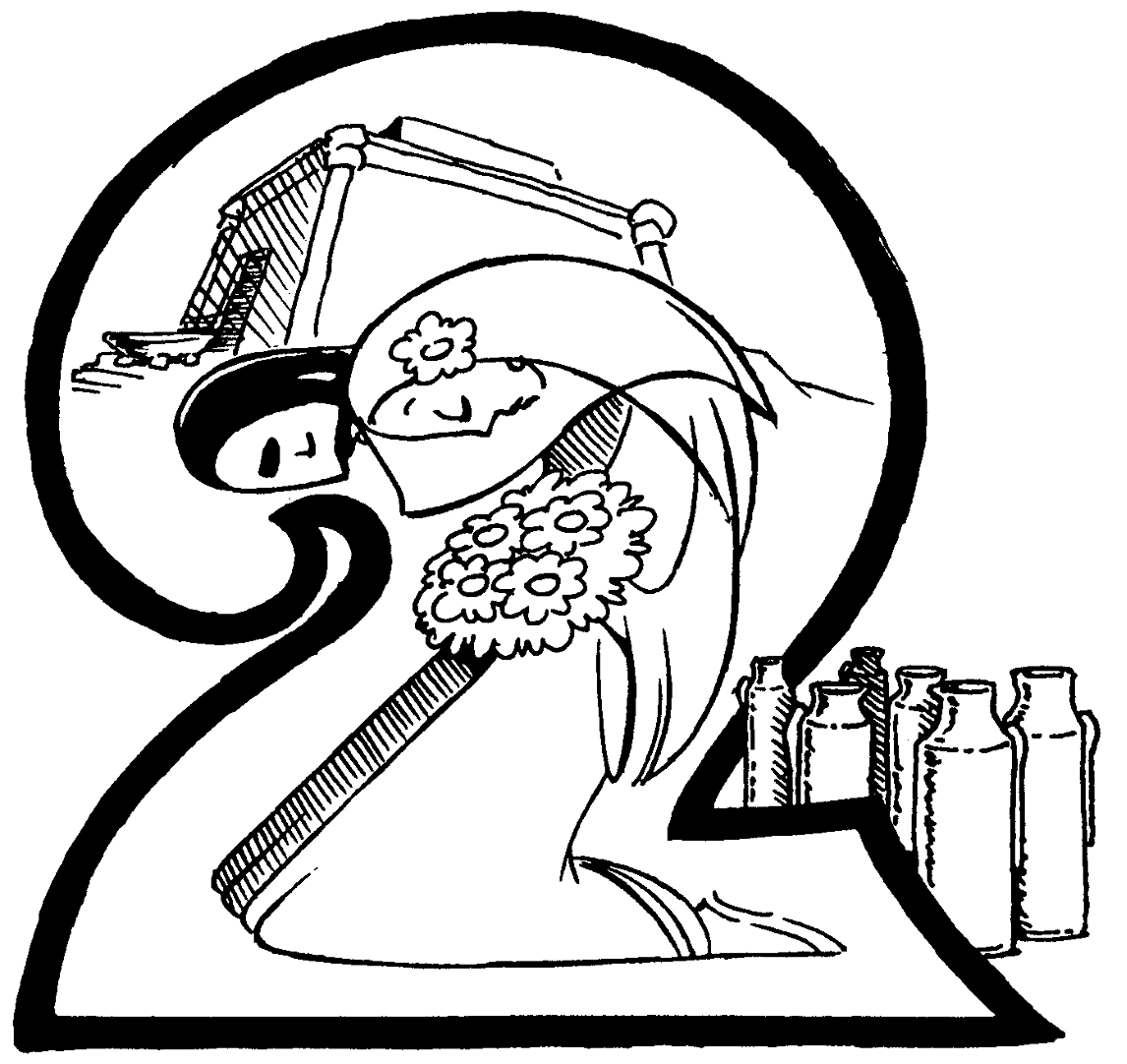
Then comes chapter 2. There are two events that take place in John 2. The wedding in Cana, where Jesus turned the water into wine, and the cleansing of the temple, when Jesus drove out the money changers. These events are nicely pictured there in chapter 2, as the bride and groom and hunched over in a kneeling position, which looks like the number, “2.” There are also six water jars that were filled with water, that would become wine. The picture also shows the temple near the top of the “2.”
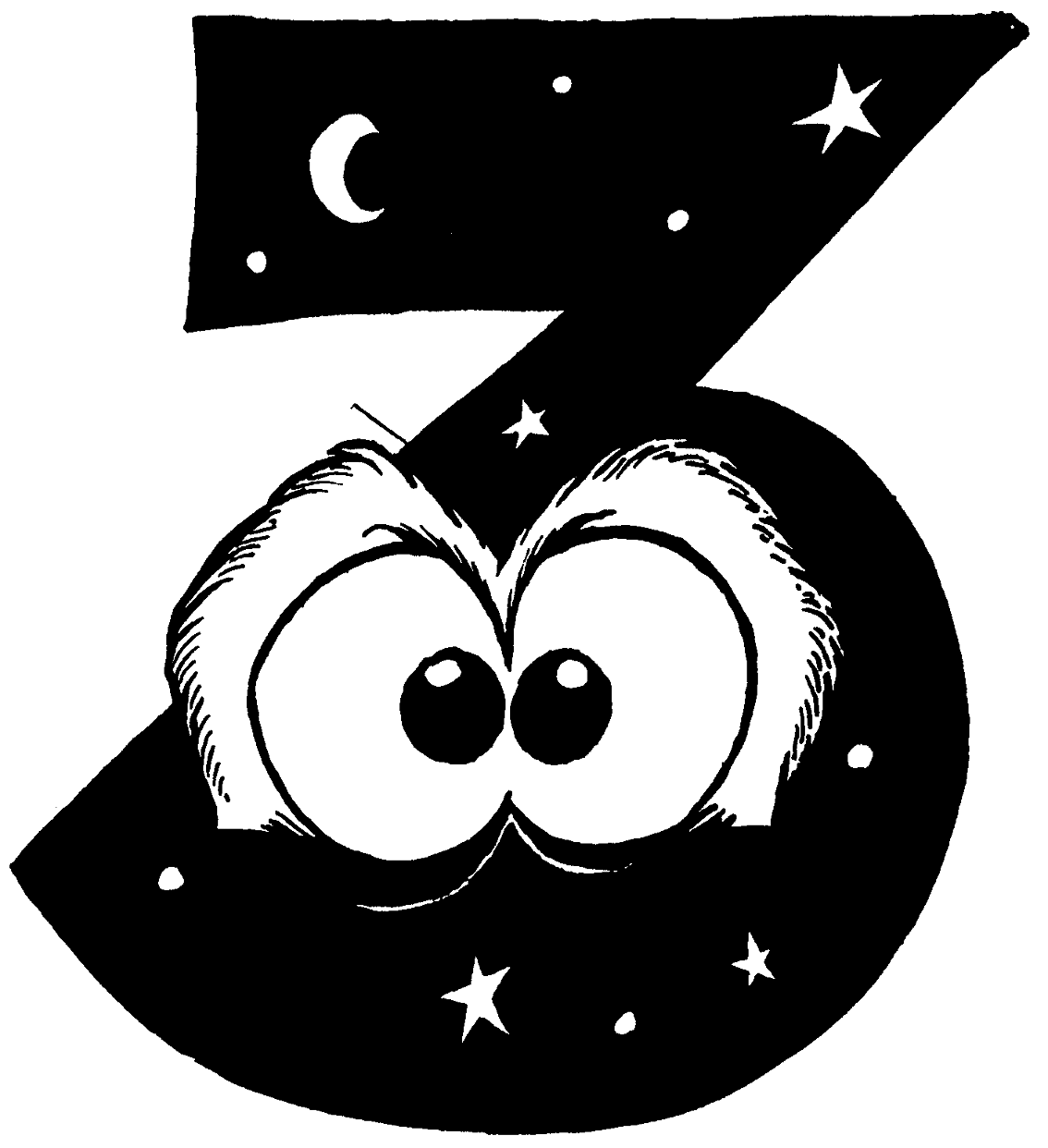
The comes chapter 3. In this picture, there are some beady eyes that are in the lower loop of the “3.” It has the moon and stars in much of the number “3,” indicating that the events in chapter 3 took place at night. The eyes represent Nicodemus. So chapter 3 could be called, “Nick at Nite.” If you know anything about chapter 3, you know that John’s final words are also in chapter 3.
These pictures of John aren’t designed that way. Rather, they help to give you a picture of a big event that happens in the chapter. These pictures are pictures of the stories in John. So, in chapter 1, we have the first words of John, along with John’s baptism. In chapter 2, we have the wedding of Cana and the cleansing of the temple. In chapter 3, we have “Nick at Nite,” when Nicodemus comes to talk with Jesus.
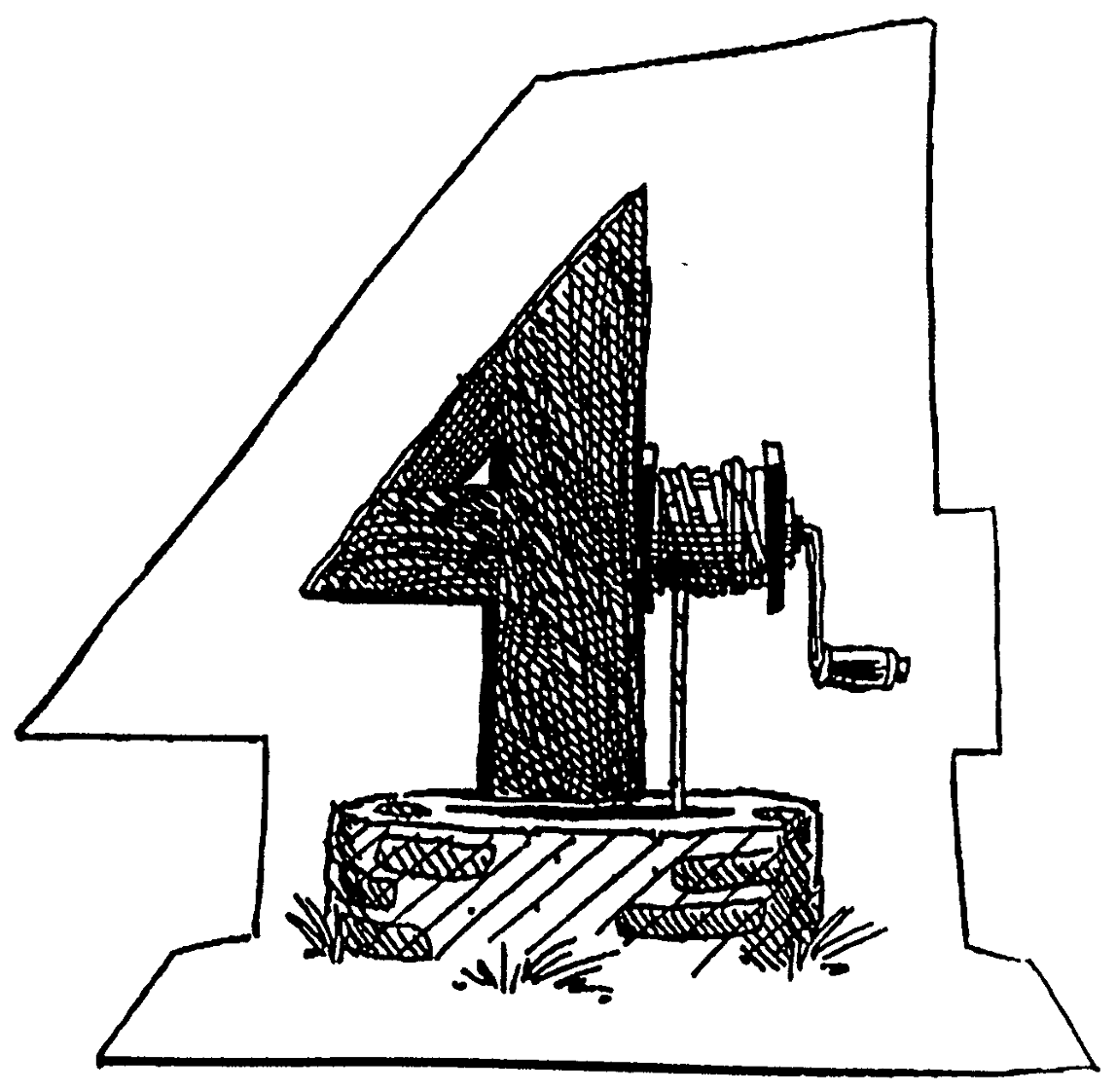
So, we come to chapter 4. This picture is a very funny looking “4” because it sort of looks like a well. In chapter 4, we have the story of the woman at the well. Now, again, this isn’t the only event in chapter 4. The story of the Official’s son being healed is in chapter 4, that isn’t depicted in the picture. But the picture is a good start. It’s super-helpful for you to know that John 4 contains the story of the woman at the well.
So, in chapter 1 we have the beginnings. In chapter 2, we have the wedding at Cana and the cleansing of the temple. In chapter 3, we have “Nick at Nite.” In chapter 4, we have the woman at the well.
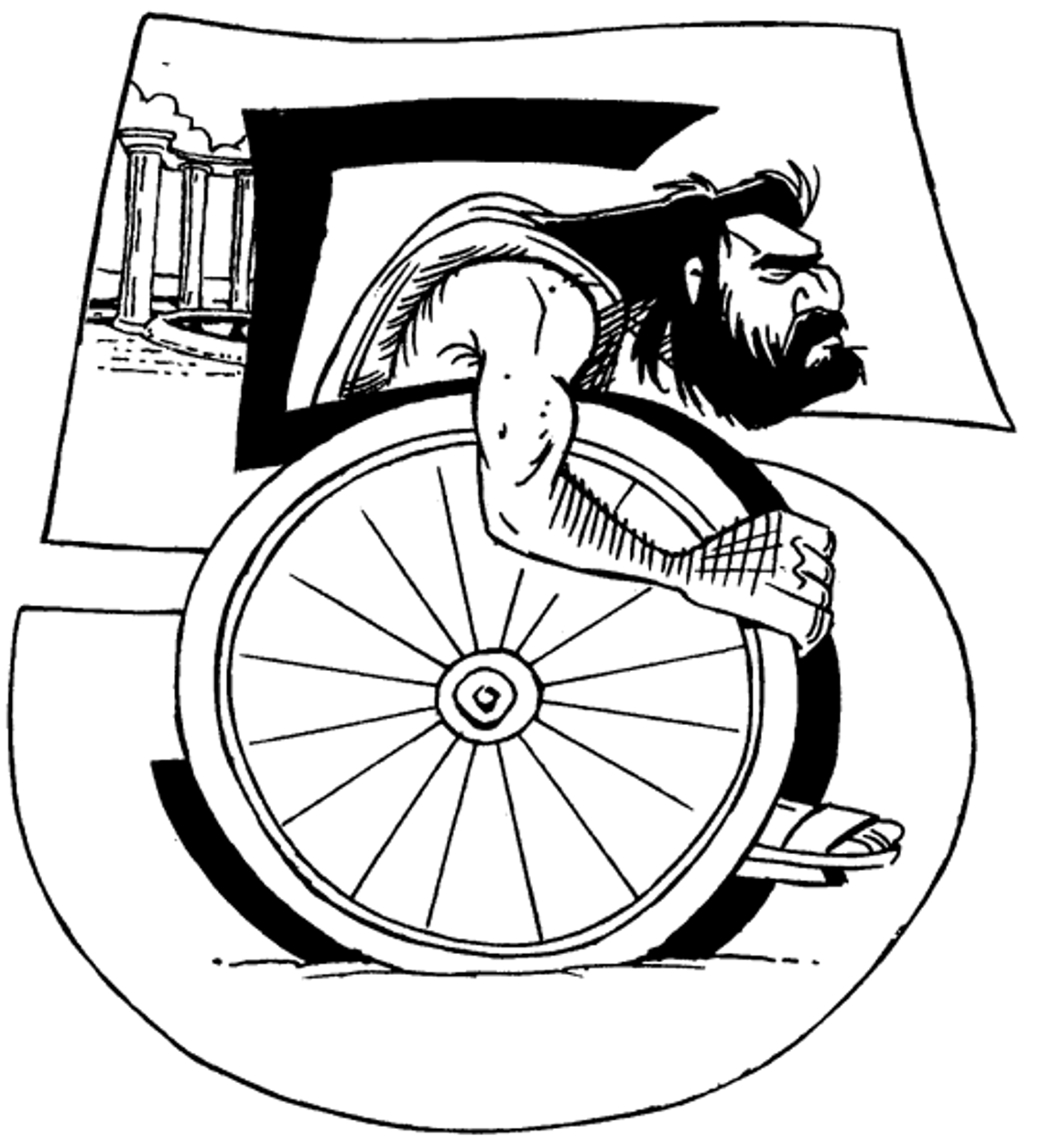
Now we come to chapter 5. For this picture you have to use your imagination, but the “5” looks like a wheelchair. This reminds us that chapter 5 tells the story of the paralytic who took up his bed and walked. At the end of chapter 5 Jesus is elling the Jews of those who give witness to him, John, his works, his Father and the Scriptures, and Moses. But that’s not included in the picture. If you can remember that a “5” looks like a wheelchair, then you'll do well to grasp the contents of John, and remember the paralytic was healed in chapter 5.
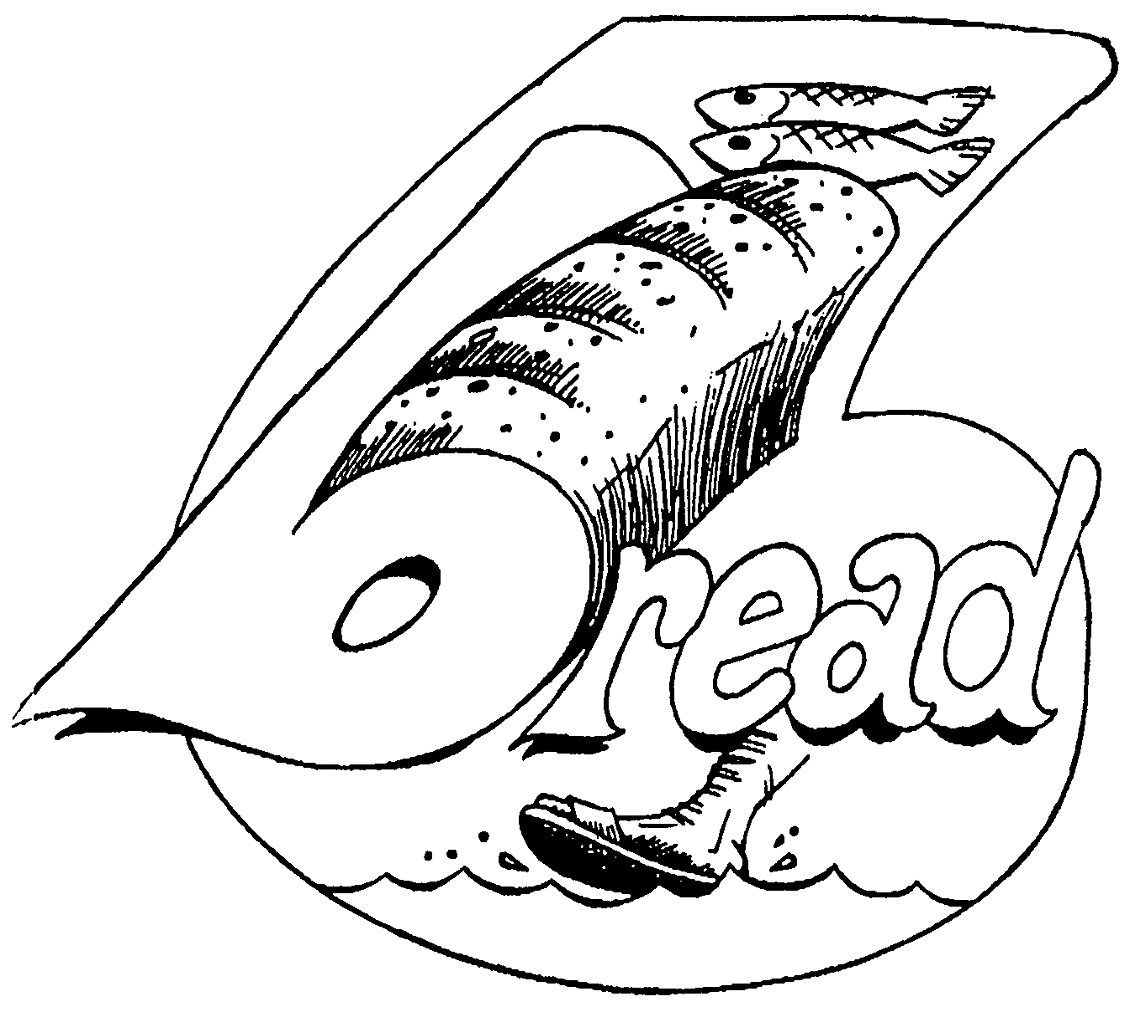
Then comes chapter 6. This picture is a strange looking “6," but with a little imagination, it can look a little bit like a small, “b.” which stands for “bread.” In chapter 6, Jesus feeds the 5,000. The number 6 also has some feet on the water. Jesus also walks on water in chapter 6. So, with this picture in mind, you will know that it’s in chapter 6 that Jesus says, “I am the bread of life.”
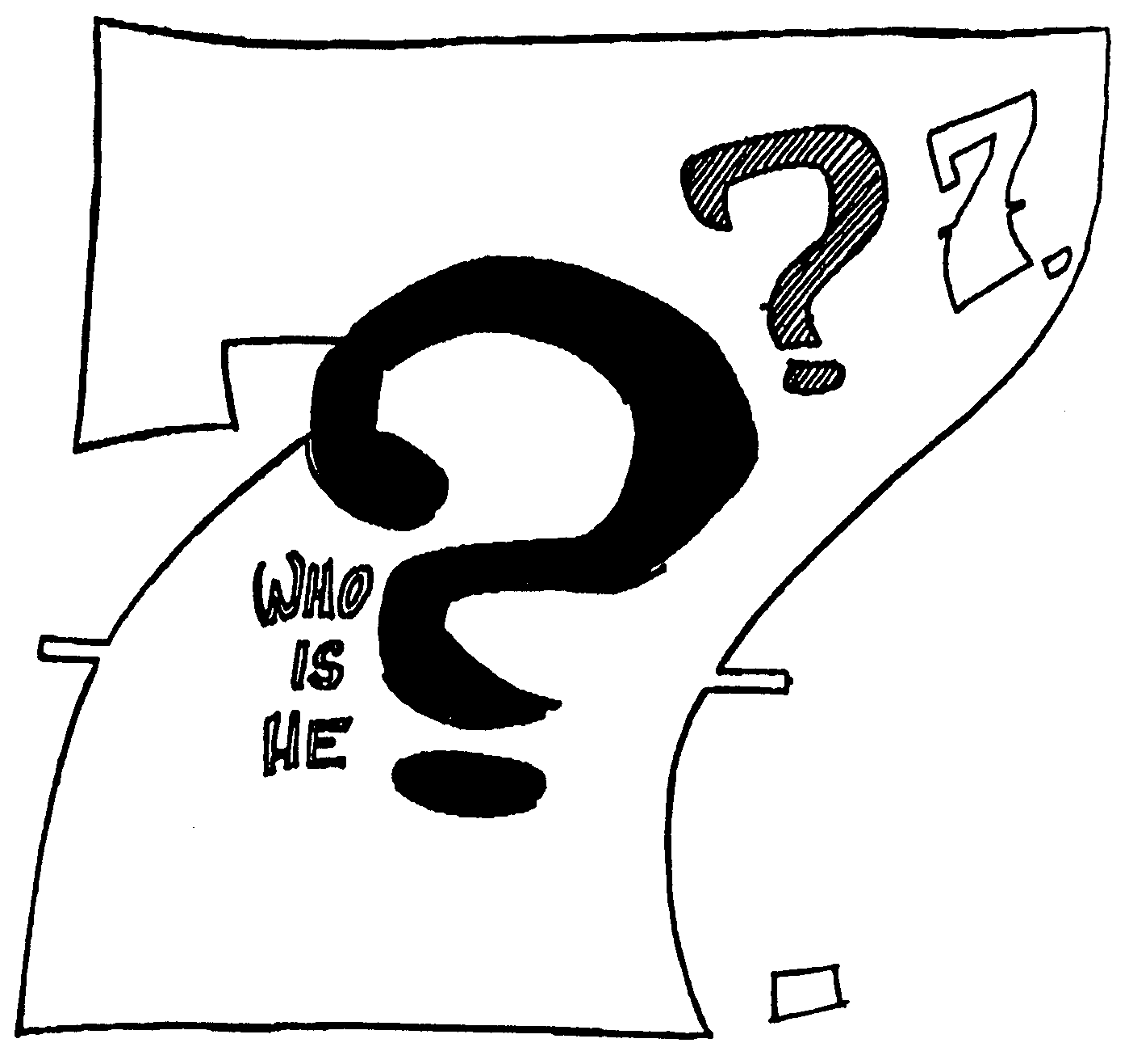
Now, we come to chapter 7. Again, it’s a strange looking chapter 7. But if you look at it right, you can see that a “7” looks much like a question mark. In chapter 7 we see many people questioning Jesus. His brothers question him, whether or not he will go up to the feast. Before Jesus arrived at the feast, the Jews were saying, “Where is he?” (John 7:11). When Jesus arrives, the people are amazed at his teaching and asked how he can have so much learning if he has never studied in the schools. When Jesus said that some were seeking to kill him, they said, “Who is seeking to kill you?” (John 7:20). When he was speaking openly (and not being arrested), the Jews said, “Do the authorities really know that this is the Christ?” (John 7:26). Then the people were wondering if Jesus was the Christ? But then, some were saying, “Is the Christ to come from Galilee?” (John 7:41). When the officers who had been sent to arrest him didn’t arrest him, their superiors said, “Why did you not bring him?” (John 7:45). “Have you also been deceived?” (John 7:47). These are but some of the questions that come up in chapter 7. But you can simply remember that a “7” looks like a question mark, then you can remember there were many questions in chapter 7 about the identity of Jesus.
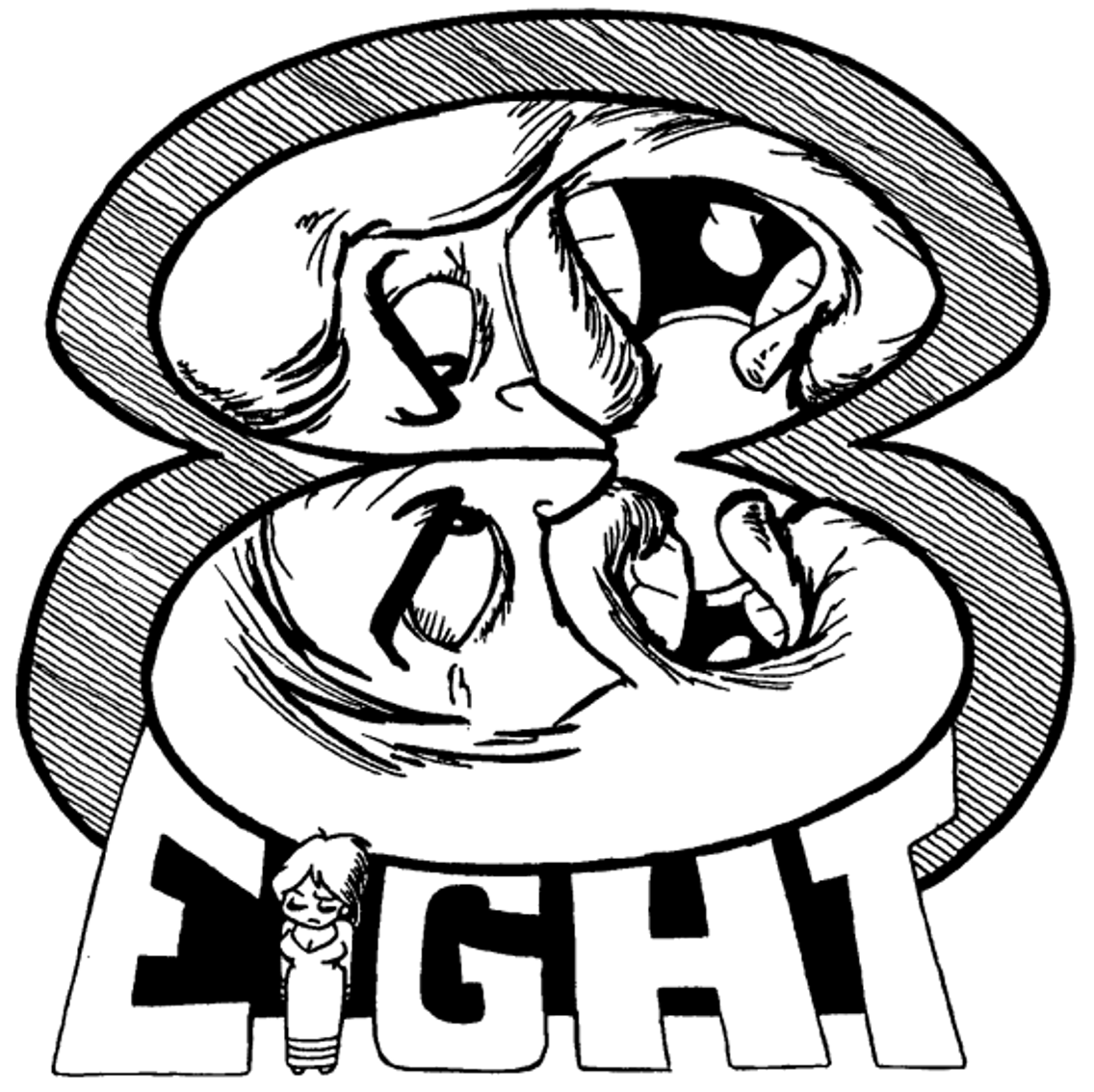
Prominent in the loops of the “8” are two people arguing strongly with each other. This is what most of chapter 8 is about. The Pharisees are arguing with Jesus about the truth and the devil and Abraham. The argument gets so heated that the Pharisees picked up stones and tried to stone him to death. But Jesus “hid himself and went out of the temple” (John 8:59). Now, you can also see in the “I” of the word, “EIGHT” at the bottom is a woman that looks ashamed. That’s because this woman was caught in adultery. That story is also included in chapter 8.
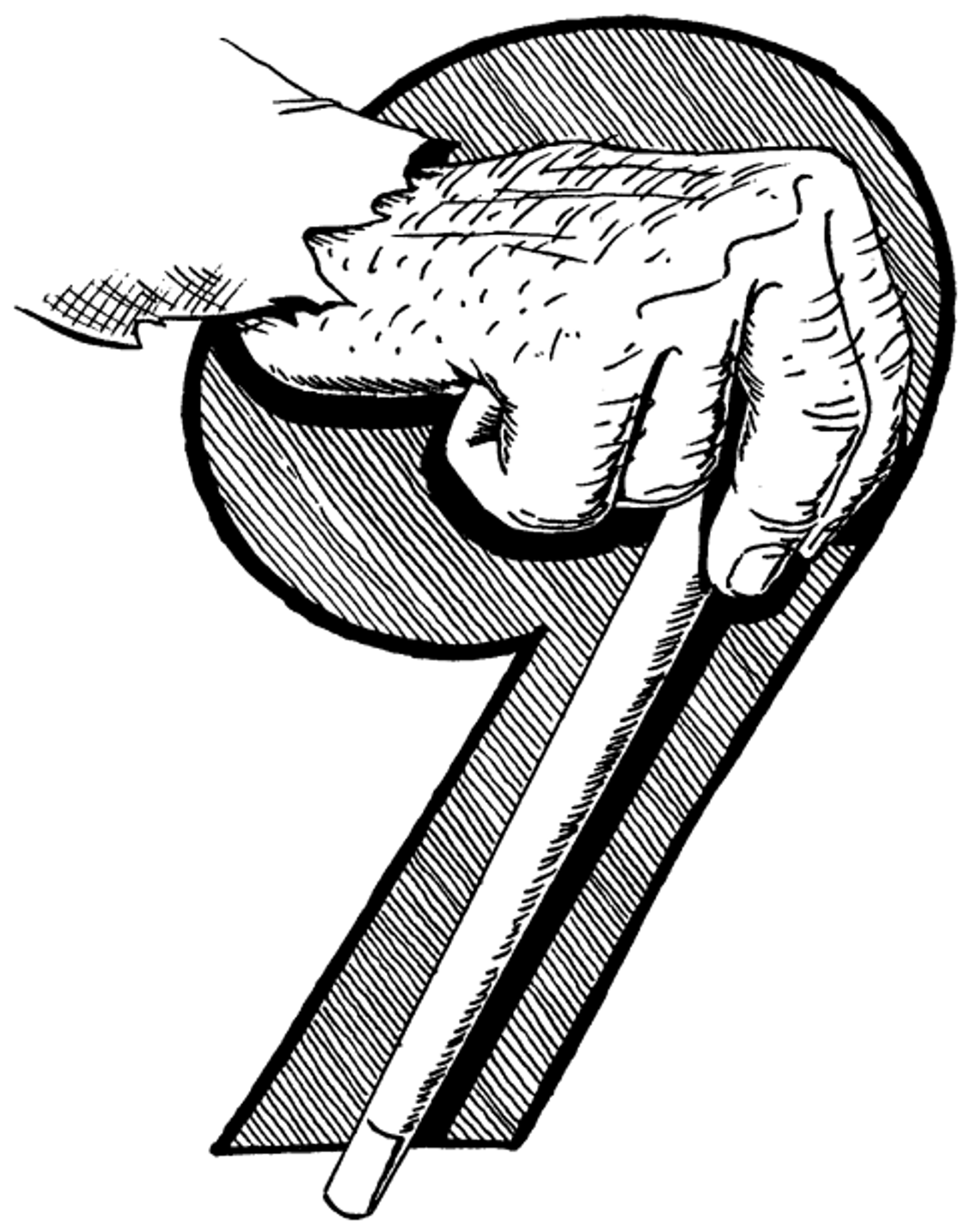
For chapter 9 you need to use your imagination. If you use your imagination, the nine looks a bit like a walking stick. A walking stick is for a blind man. The blind man was healed in John 9. The entire chapter is devoted to this story. So statements like, “I am the light of the world” shows up in chapter 9 (John 9:5).
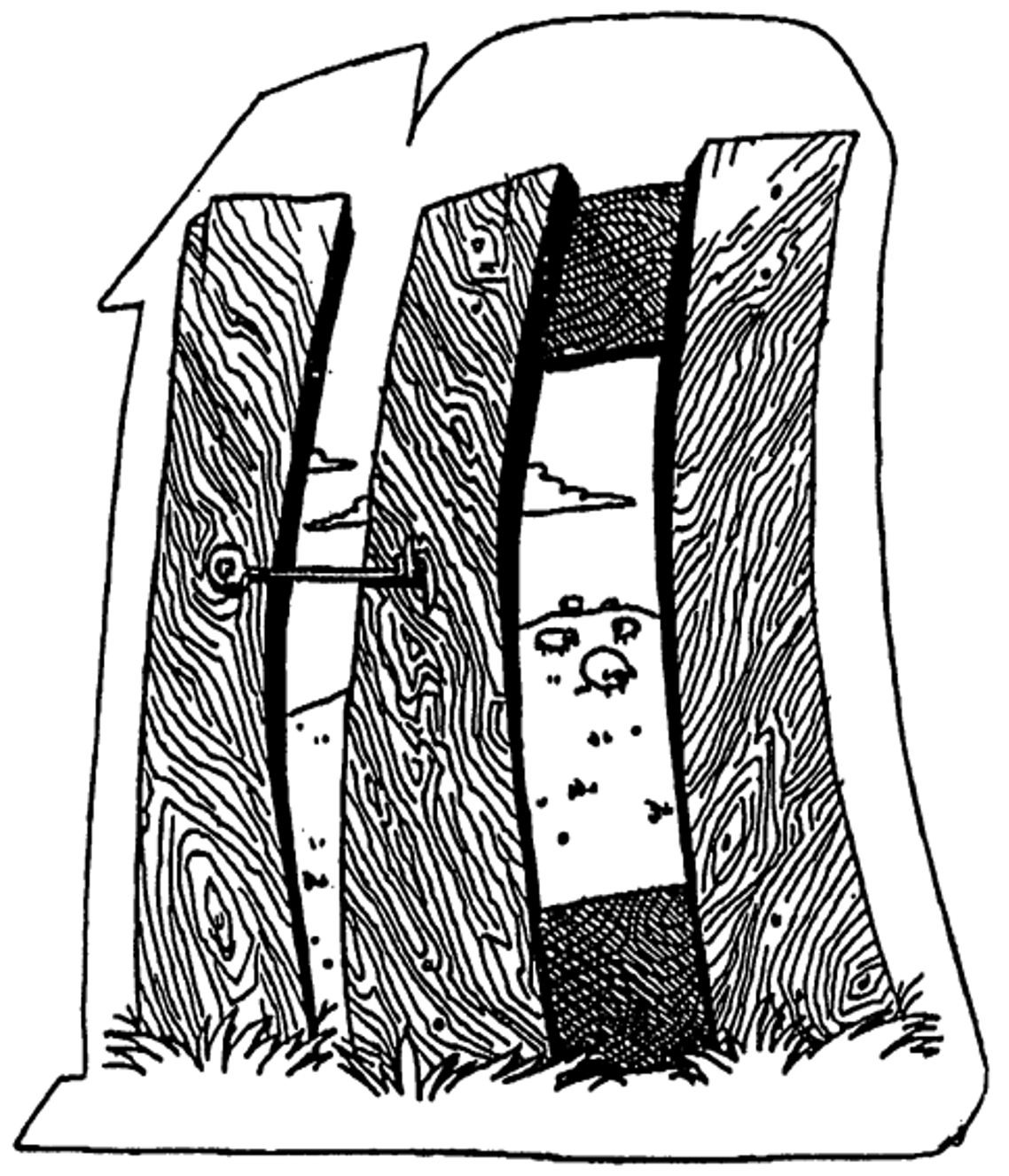
Chapter 10 also is an odd looking number, but this shape looks something like a gate. The picture shows that this is a gate to a pasture-land where there are some sheep. John 10 is where Jesus said, “I am the door” (John 10:7), and “I am the good shepherd” (John 10:11). Of course, there are more things in chapter 10 than this. But if you remember the picture of the gate, it will help you to grasp the big picture of John.
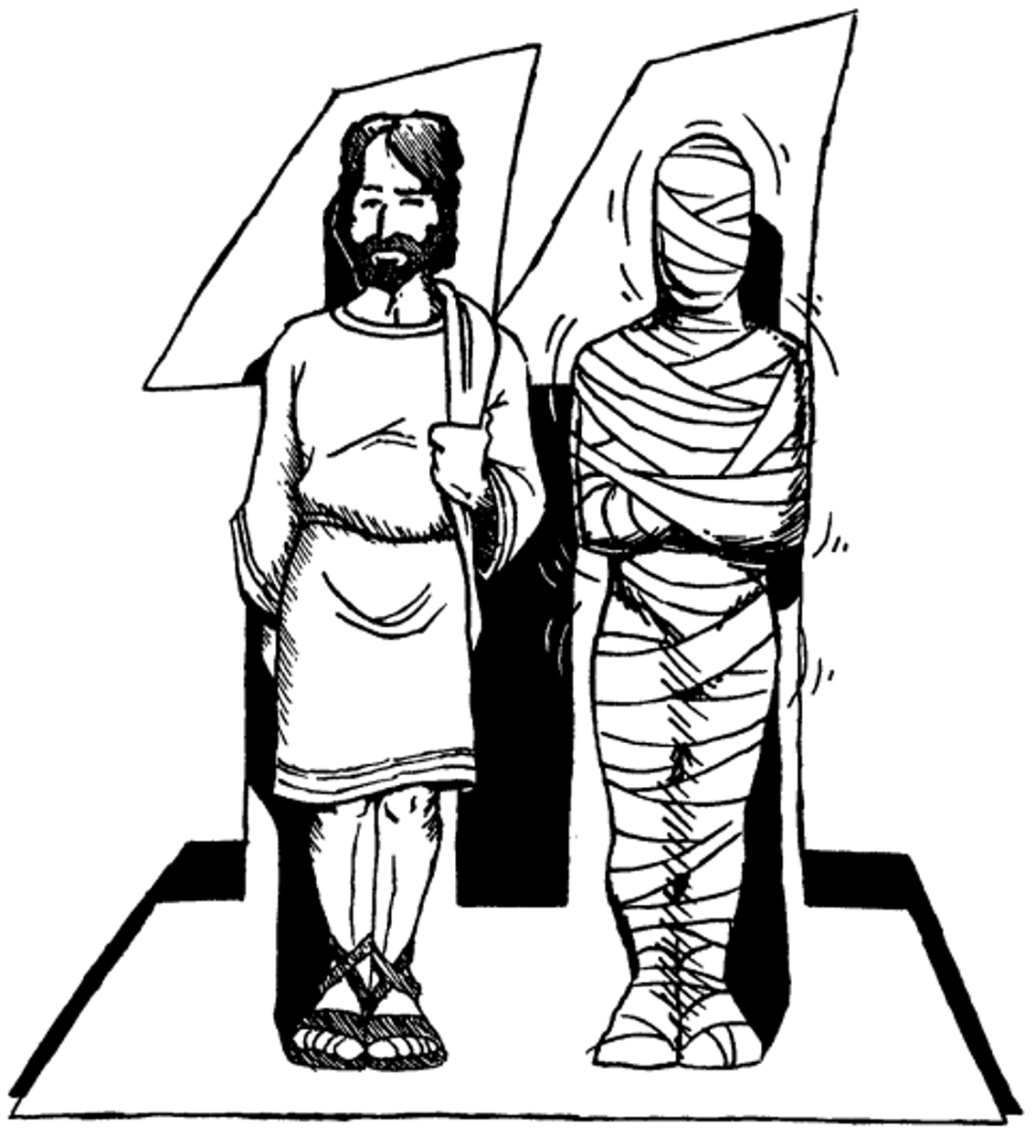
Now we come to chapter 11. You can think about the “1’s” in the eleven as people standing tall. One is Jesus. One is Lazarus. Both of them alive and well. Chapter 11 tells the story of Jesus raising Lazarus from the dead. So, it’s in chapter 11 where Jesus says, “I am the resurrection and the life. Whoever believes in me, though he die, yet shall he live” (John 11:25).
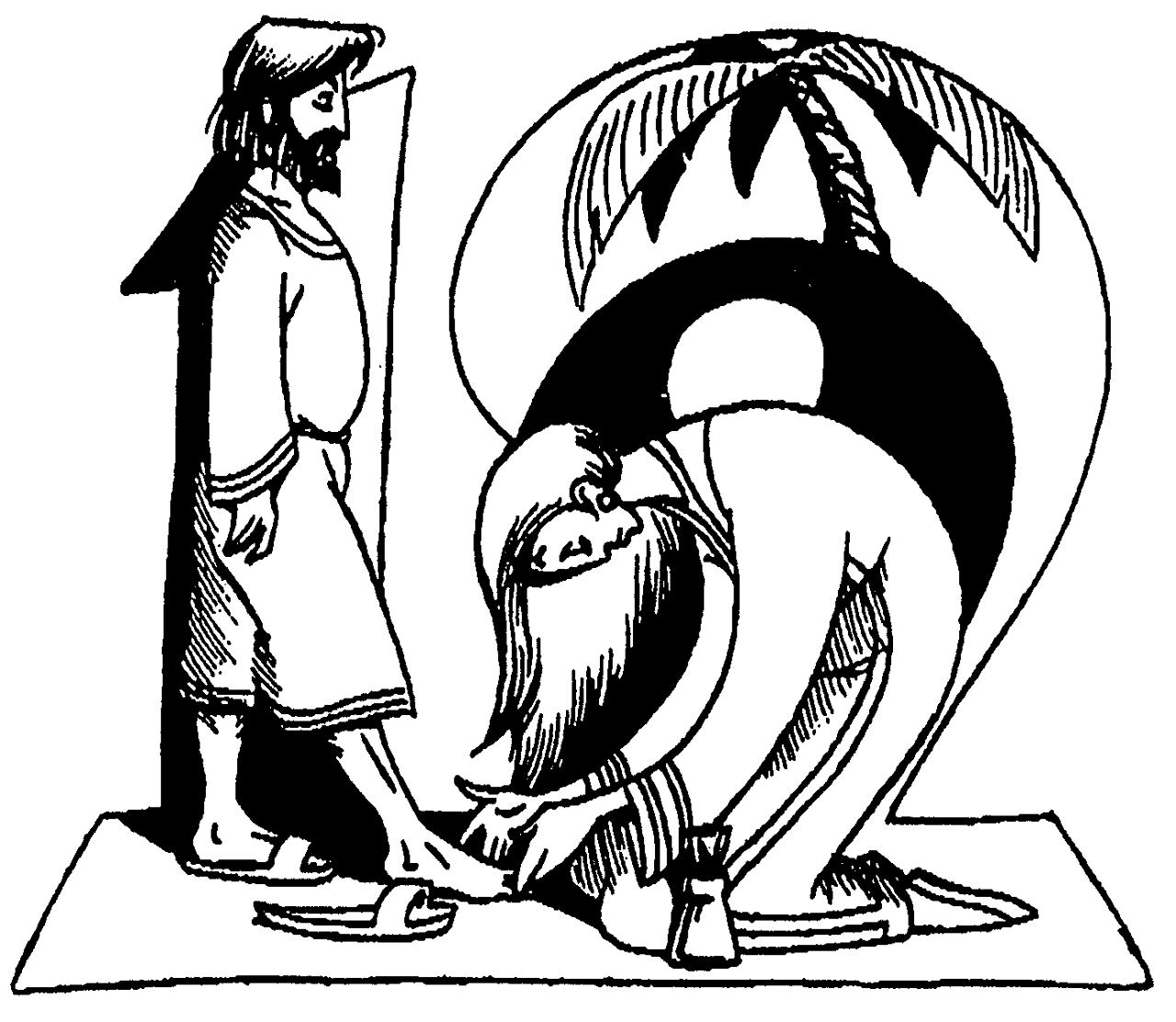
Then comes chapter 12. Again, like in chapter 2, the “2” looks like someone kneeling. The “1” looks like somebody standing. In chapter 12, we see Mary anointing the feet of Jesus. Also, if you look in the top arch of the “2,” you see a palm tree. This can remind you that the story of the triumphal entry is told in chapter 12, what we celebrate every Palm Sunday. Of course, there are other things mentioned in chapter 12, but these are the two big events: The anointing of Jesus and the Triumphal Entry of Jesus into Jerusalem on Palm Sunday.
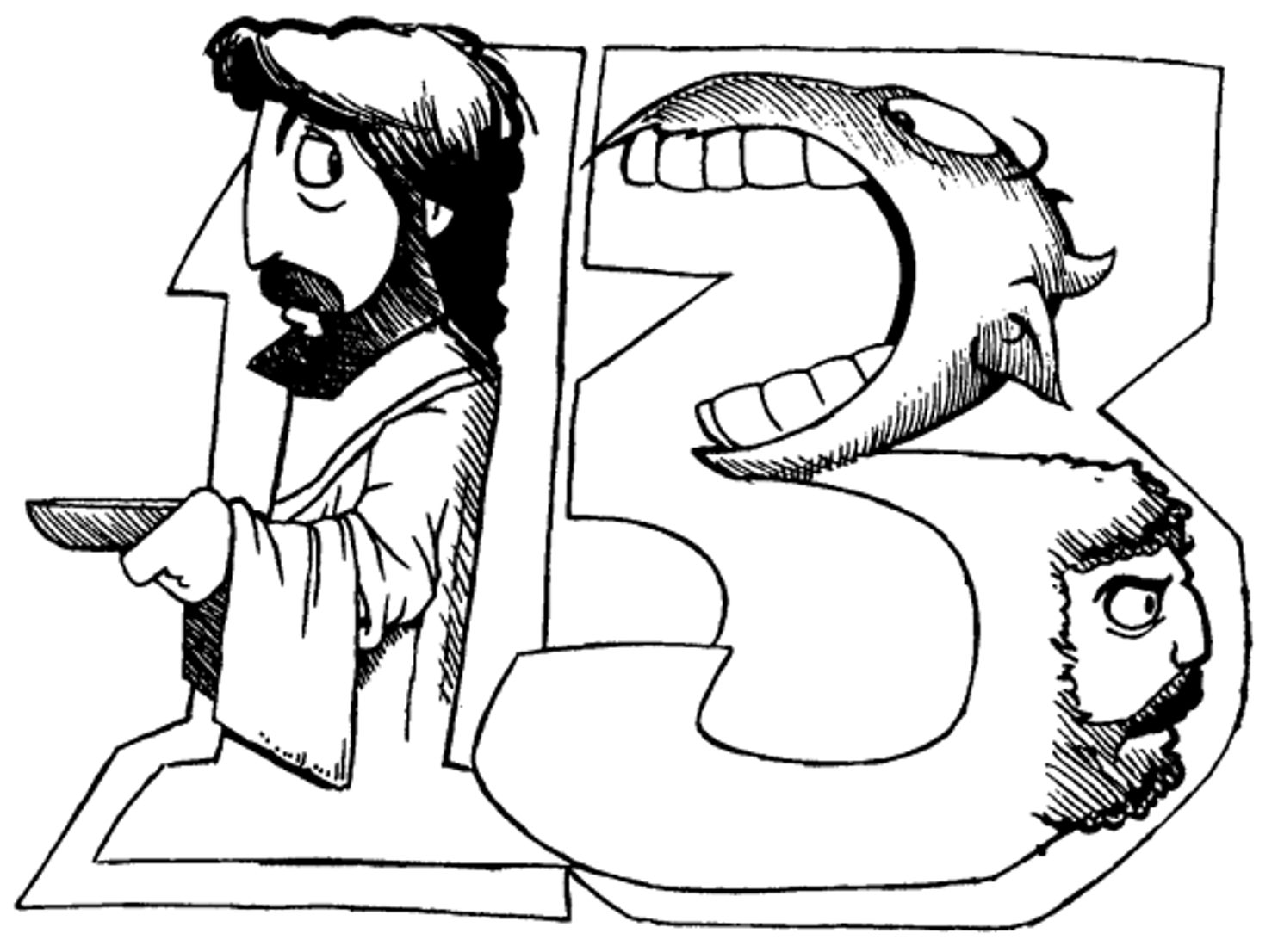
For Chapter 13 The “1” looks again, like someone is standing up. The “3,” if you are creative, can look like someone about to chomp down on the “1.” Jesus has a towel and basin in hand, ready to wash the feet of the disciples. After that special moment, Judas will go out and betray him, as the devil had already entered his heart to betray Jesus (John 13:2). It’s the devil who’s waiting to pounce on Jesus.
The next four chapters get clumped 4 chapters together, chapters 14-17. The reason why is because of how no great events happen during this time. Jesus is with the disciples teaching them what is necessary as he is about to be crucified and leave the earth.
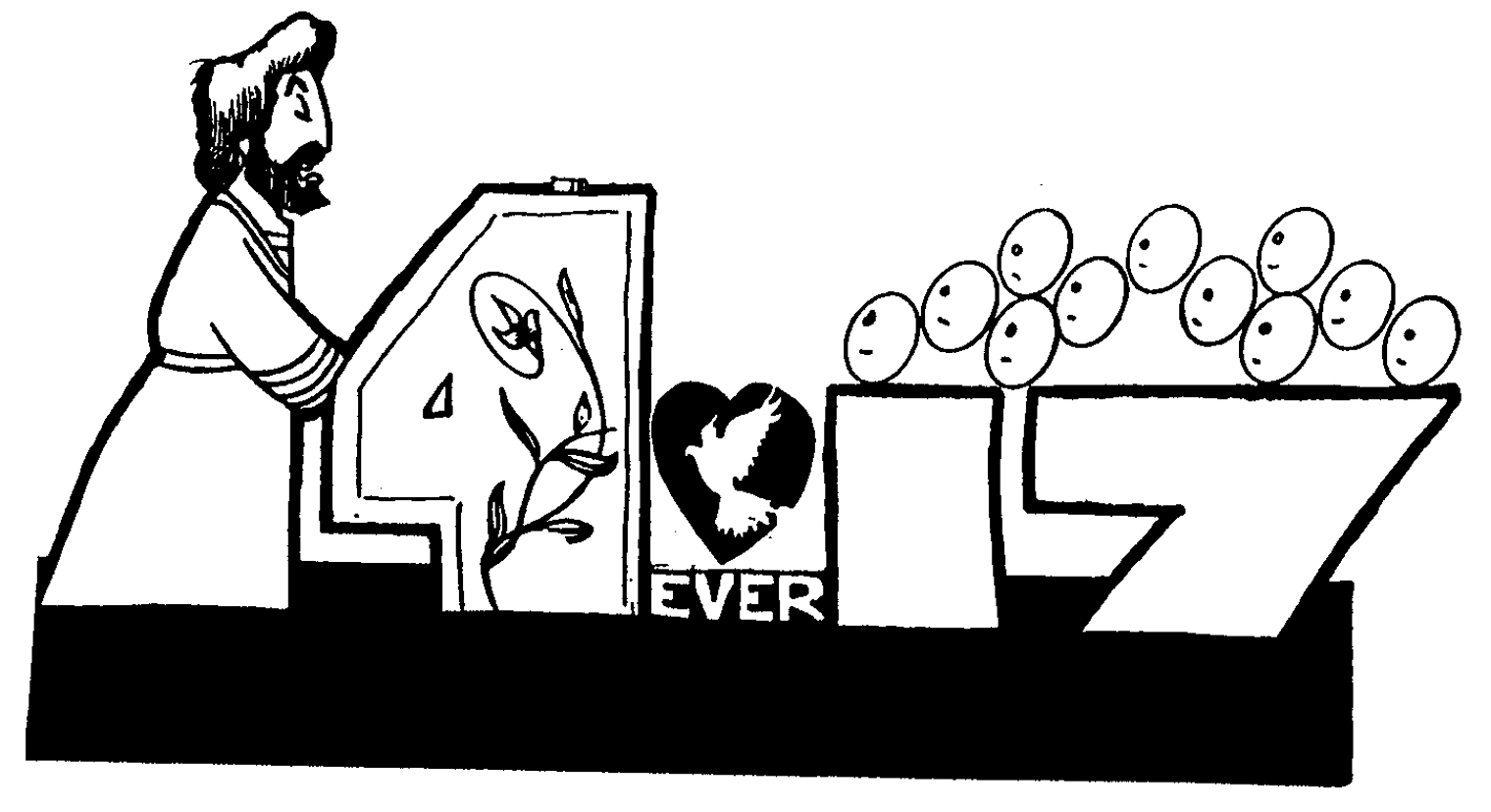
You see Jesus on the left, where the “1” of the “14” was. He is talking with the eleven disciples, teaching them. One central topic of conversation comes in chapters 14 and 16. The topic of the Holy Spirit arises. You can see the dove symbol there between the 14 and the 16. Jesus sends that he will send the Spirit, who he calls, “the Helper.” He will guide the disciples in all truth (John 14:17; 16:13). He will teach them all things (John 14:26). You can see the vine there growing. In chapter 15, Jesus says, “I am the vine.” In chapter 17, Jesus prays for himself, the disciples and the world.
On to the last four chapters. Here is the picture for chapter 18.
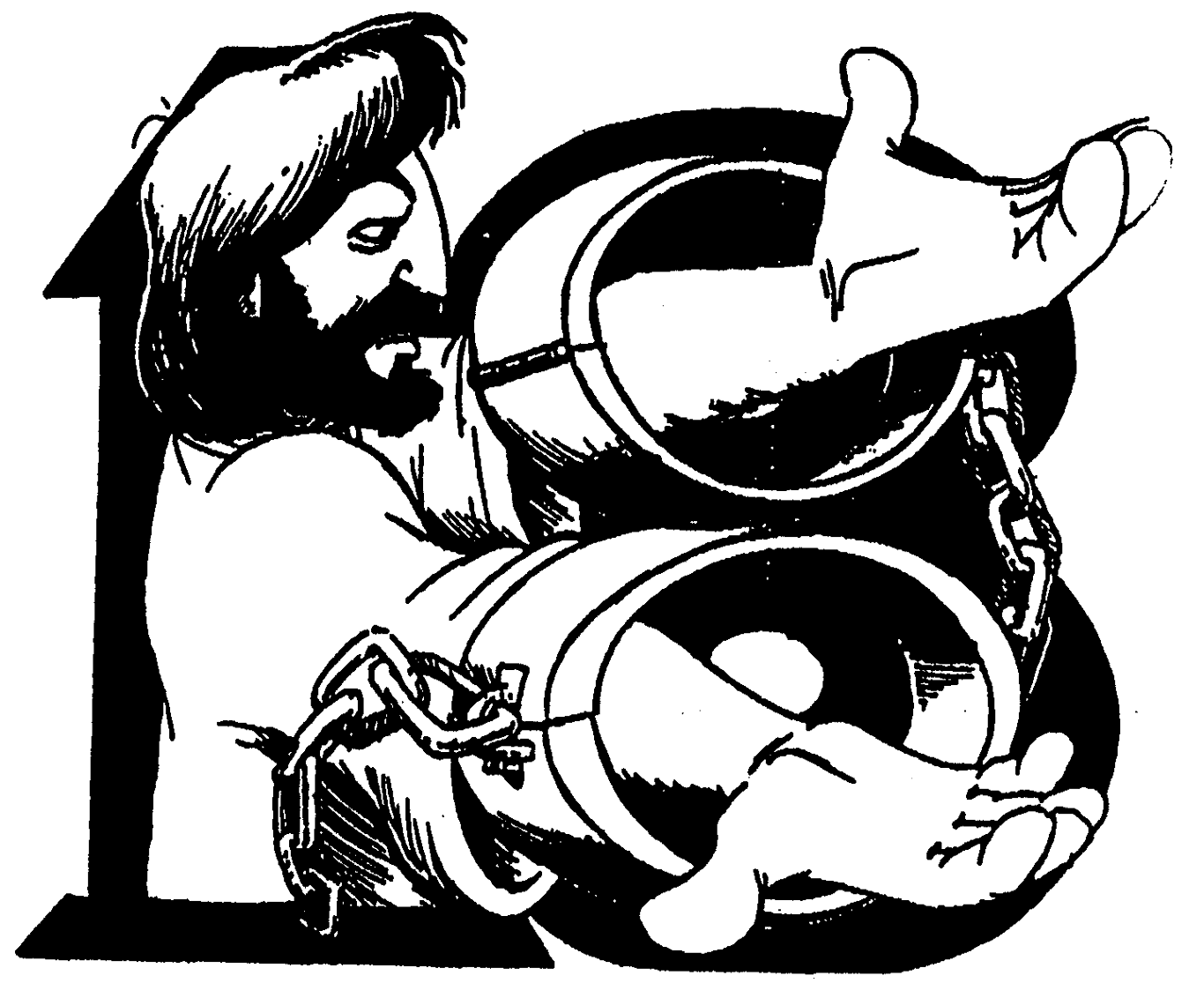
Like the others, the “1” looks like a person. The “8” looks like some handcuffs. So, here’s what we get: In chapter 18, Jesus was betrayed, arrested, and brought on trial.
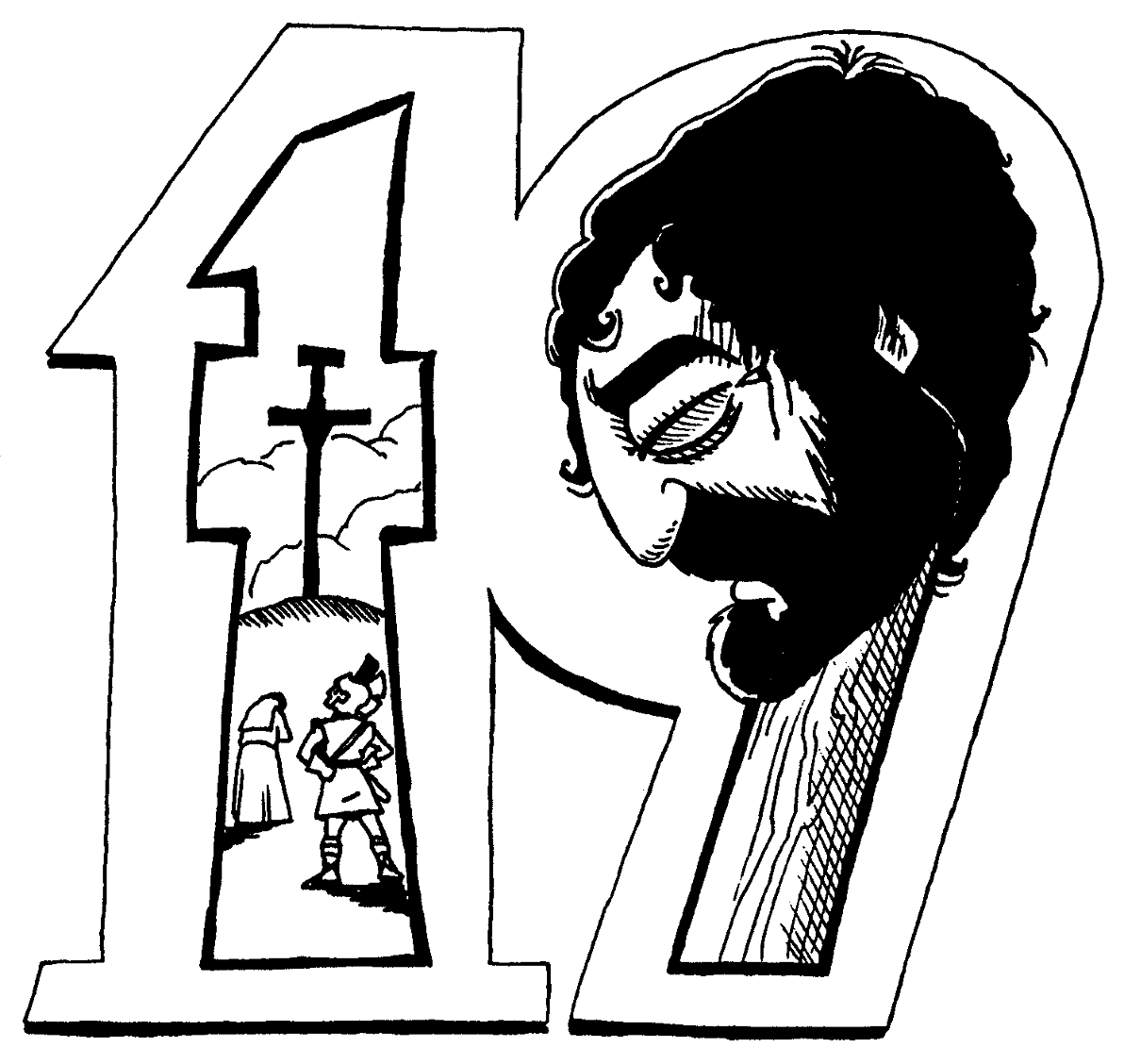
Now, we come to chapter 19. This is the sad chapter, when Jesus dies on the cross. The “9” in the 19 looks like a drooping head. You can think of it as the drooping head of Jesus upon the cross. Chapter 19 contains the story of the flogging of Jesus, the crucifixion of Jesus, and his burial.
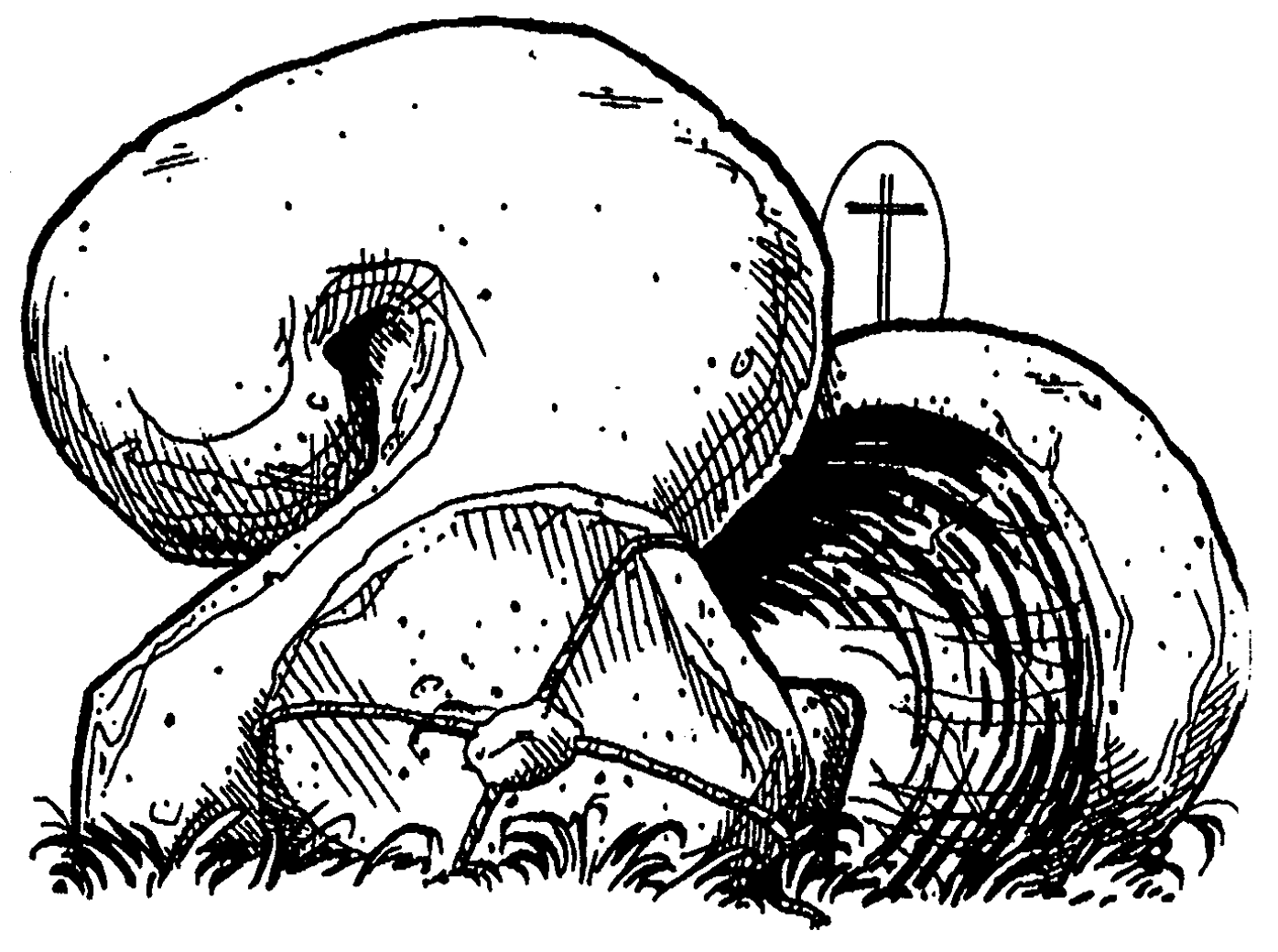
This is a picture of a rolling stone tomb, much like the tomb where Jesus would have been buried. Chapter 20 is a glorious chapter! It’s of the resurrection and the appearances of Jesus to Mary in the garden, and the disciples, and Thomas! Now we come to the last chapter.
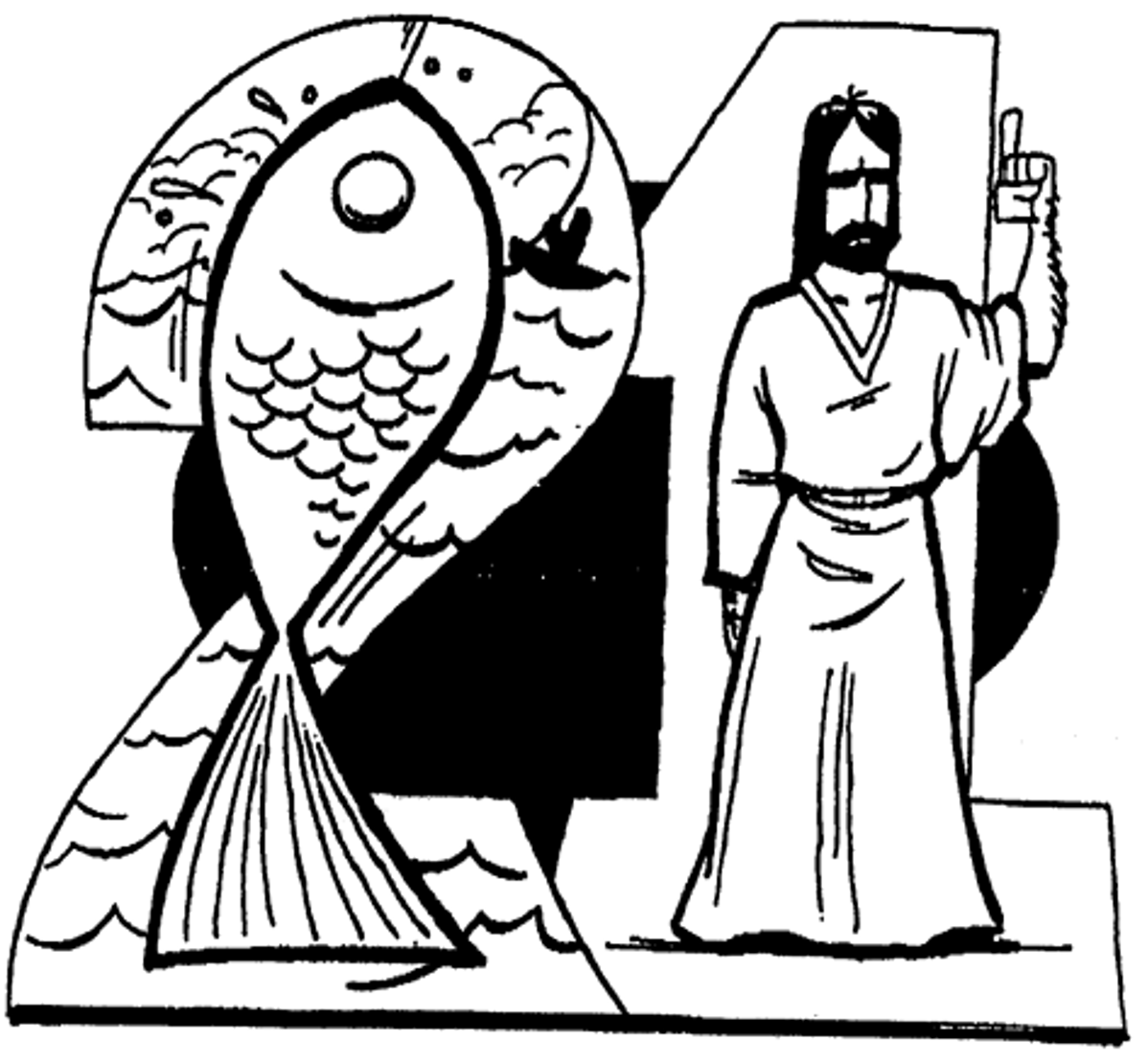
In chapter 21, we read of more appearances of Jesus. He appears to his disciples, who are out fishing. They fished all night but caught nothing. So Jesus calls out to them, “Cast the net on the right side of the boat, and you will find some” (John 21:6). When they cast their net and gathered so many fish that they couldn’t even take all of the fish into the boat. Peter rightly discerned that it was Jesus on the shore! Thus, because of the picture, I understand what the fish is about. Though, I’m not quite sure what Jesus giving the “#1” sign means.
There's the book of John. That was a super-long introduction, but it should help you all as you think about the book of John. It will also help you in the prologue, as events and themes from John are included in the prologue. So, turn in your Bibles to John, chapter 1. Let me read the prologue (er, the overture) once again. Consider the events and themes in light of the book of John.
John 1:1-18
In the beginning was the Word, and the Word was with God, and the Word was God. He was in the beginning with God. All things were made through him, and without him was not any thing made that was made. In him was life, and the life was the light of men. The light shines in the darkness, and the darkness has not overcome it.
There was a man sent from God, whose name was John. He came as a witness, to bear witness about the light, that all might believe through him. He was not the light, but came to bear witness about the light.
The true light, which gives light to everyone, was coming into the world. He was in the world, and the world was made through him, yet the world did not know him. He came to his own, and his own people did not receive him. But to all who did receive him, who believed in his name, he gave the right to become children of God, who were born, not of blood nor of the will of the flesh nor of the will of man, but of God.
And the Word became flesh and dwelt among us, and we have seen his glory, glory as of the only Son from the Father, full of grace and truth. (John bore witness about him, and cried out, “This was he of whom I said, ‘He who comes after me ranks before me, because he was before me.’”) For from his fullness we have all received, grace upon grace. For the law was given through Moses; grace and truth came through Jesus Christ. No one has ever seen God; the only God, who is at the Father's side, he has made him known.
Let's review John 20:31, as it is what John's prologue has been all about: “These are written so that you may believe that Jesus is the Christ, the Son of God, and that by believing you may have life in his name." This is what the gospel of John is all about!
With what little time left we have, we are going to be looking at verses 14-18. Like we have done with all of my messages on the prologue, I want to pick out themes from these verses, and then, look to the gospel of John, and see them illustrated. By way of outline, I want to give you four words that help to summarize this passage, and for that matter, the entire book of John. All of these words occur in verse 14. The first word is this:
1. Dwelt (verse 14)
You can see this in verse 14,
John 1:14
And the Word became flesh and dwelt among us,
This verse talks about Jesus coming to earth. It’s the word (identified in verse 1 as “God”), coming into the flesh to dwell among us, as one of us. It was the creator, who stepped into his creation. It was God, who took on flesh. He became a man. He became fully human. He “dwelt” among us. Literally, Jesus “pitched his tent” among us. It was as if Jesus came to be with us for a little while. He became a man, who lived with us and walked with us and talked with us.
That’s really the motif of the entire book of John. It tells the story of Jesus, the God-man who came to earth to live with us. If you think about the pictures of the chapters, you can see a few things of what Jesus did while among us. He experienced joy. Do you remember what took place in chapter 2? The wedding in Cana. Where there was great celebration! A man and a woman coming together in holy matrimony. Few things are more joyful in life than a good wedding. Jesus joined right in with the joy, providing more wine for the party.
Jesus felt fatigue, like in chapter 4, when he was sitting at the well and met the woman who had come to draw out water. The disciples had gone into town to get some food, but Jesus was wearied, and so, he sat down by the well. He felt emotions, like when Lazarus died. He wept (John 11:35). He felt the pain of betrayal. Chapter 13 tells the story of when he washed the disciple’s feet when Judas left him to betray him. The details of the betrayal is told in chapter 18, when he was arrested.
He felt the pain of death and dying. Chapter 19 records his death upon the cross for our sins. That’s Jesus dwelling among us.
Let’s turn to our second word:
2. Glory (verses 14-15)
We see it there in verse 14,
John 1:14
And the Word became flesh and dwelt among us, and we have seen his glory, glory as of the only Son from the Father.
When Jesus was dwelling upon the earth, he was showing forth his glory. John says that those around him saw his glory. Certainly, John the Baptist recognized the glory of Jesus.
John 1:15
(John bore witness about him, and cried out, “This was he of whom I said, ‘He who comes after me ranks before me, because he was before me.’”)
John was becoming one of the most influential religious leaders of his day. Not by political position, but by religious influence. Many were coming to him in the wilderness to hear him preach. Many were turning from their sins. As a result, he was baptizing many in the Jordan river. Yet, he said that Jesus had a higher rank that John himself had. That’s the glory of Jesus.
We especially see his glory in the signs that he did. In chapter 2, Jesus turned the water into wine. We read in John 2:11, "This, the first of his signs, Jesus did at Cana in Galilee, and manifested his glory." In chapter 5, Jesus healed the lame man. Again, this was an illustration of the glory of Jesus, as he showed his healing ability, telling the man who had been an invalid for 38 years, “Get up, take up your bed, and walk” (John 5:8).
In chapter 6, Jesus fed the 5,000 and walked on water. That was a display of the glory of Jesus. He has the ability to create food for the crowds. He has the ability to defy the laws of physics and walk on the water. In chapter 9, Jesus healed the man born blind. This was also a display of the glory of Jesus. He was able to cure blindness! far beyond what any physician can do today. In chapter 11, Jesus raised Lazarus from the dead! This is the glorious power of Jesus on full display! Jesus comes to the tomb and says, “Take away the stone” (John 11:39). Then he says, “Lazarus, come out” (John 11:43). Lazarus, whose hands and feet were bound with linen strips from his burial, came out of the tomb!
Perhaps the greatest display of the glory of Jesus comes in chapter 20, when Jesus rises from the dead! This is where the story of John is headed! Jesus, the God-man, who lived among us, who showed his great power and authority and was killed on the cross, but raised from the dead, appeared to his disciples. "....So that all who believe in him may have eternal life (John 3:16; 20:31).
OK, let’s move on to our third word:
3. Grace (verses 16-17)
We see this in verse 14.
John 1:14
And the Word became flesh and dwelt among us, and we have seen his glory, glory as of the only Son from the Father, full of grace and truth.
John further elaborates on this grace in verses 16 and 17.
John 1:16-17
For from his fullness we have all received, grace upon grace. For the law was given through Moses; grace and truth came through Jesus Christ.
When John thinks about the life of Jesus, he thinks about his grace. He says that Jesus was “grace upon grace.” If you think through the pictures of the chapters of John, you can see the grace and kindness and mercy that Jesus brought. The woman at the well comes to my mind. Jesus speaks with her, a woman, a Samaritan woman, a sinful, Samaritan woman. And yet, it is to her that he first reveals himself as the Messiah (John 4:26). Jesus showed his grace in the healings he performed. The paralytic in chapter 5, the blind man in chapter 9, and Lazarus in chapter 11. These healings where the grace and glory of Jesus intersect!
One of the greatest displays of the grace of Jesus comes in chapter 13, and how Jesus treated Judas. Chapter 13 begins with these words:
John 13:1-5
Now before the Feast of the Passover, when Jesus knew that his hour had come to depart out of this world to the Father, having loved his own who were in the world, he loved them to the end. During supper, when the devil had already put it into the heart of Judas Iscariot, Simon's son, to betray him, Jesus, knowing that the Father had given all things into his hands, and that he had come from God and was going back to God, rose from supper. He laid aside his outer garments, and taking a towel, tied it around his waist. Then he poured water into a basin and began to wash the disciples' feet and to wipe them with the towel that was wrapped around him.
The grace of Jesus toward Judas is amazing. Chapter 13 records the story of Jesus washing the feet of the disciples, including Judas. Jesus knew that he would betray him. Yet, he showed kindness to him, even in the face of his opposition, washing his feet. But perhaps there is no bigger display of the grace of Jesus than in chapter 8, with the woman caught in adultery. The dominant motif of chapter 8 is the conflict that Jesus has with the Pharisees. However, don’t miss what takes place at the beginning of the chapter. I can do no better than merely read the story for you.
John 8:2-11
Early in the morning he came again to the temple. All the people came to him, and he sat down and taught them. The scribes and the Pharisees brought a woman who had been caught in adultery, and placing her in the midst they said to him, “Teacher, this woman has been caught in the act of adultery. Now in the Law, Moses commanded us to stone such women. So what do you say?” This they said to test him, that they might have some charge to bring against him. Jesus bent down and wrote with his finger on the ground. And as they continued to ask him, he stood up and said to them, “Let him who is without sin among you be the first to throw a stone at her.” And once more he bent down and wrote on the ground. But when they heard it, they went away one by one, beginning with the older ones, and Jesus was left alone with the woman standing before him. Jesus stood up and said to her, “Woman, where are they? Has no one condemned you?” She said, “No one, Lord.” And Jesus said, “Neither do I condemn you; go, and from now on sin no more.”
This is grace in action. The scribes and Pharisees were ready to apply the law of Moses, which required death for adultery. Leviticus 20:10 says "If a man commits adultery with the wife of his neighbor, both the adulterer and the adulteress shall surely be put to death." That was the law that was given through Moses. That’s what this woman deserved. Yet, we read in our text this morning, in verse 17:
John 1:17
For the law was given through Moses; grace and truth came through Jesus Christ.
We see the grace of Jesus on full display here in the story of the woman caught in adultery. Jesus didn’t demand the death that the law required. Rather, he extended his grace to her: “Neither do I condemn you; go, and from now on sin no more" (John 8:11). This is the hope of the gospel that we see in the book of John! The law comes to condemn. But Jesus comes to give us life. He gives us life through his death. He died in our place, to bear the wrath of God for us. That we might escape his wrath, and enjoy eternal life with him! John is written, to put the full grace of Jesus on display.
Ok, let’s look at our last word:
4. Truth (verses 17-18)
Again, we see this word mentioned in verse 14.
John 1:14
And the Word became flesh and dwelt among us, and we have seen his glory, glory as of the only Son from the Father, full of grace and truth.
We see this word also mentioned in verse 17.
John 1:17
For the law was given through Moses; grace and truth came through Jesus Christ.
But this is really exemplified in verse 18.
John 1:18
No one has ever seen God; the only God, who is at the Father's side, he has made him known.
What a strange verse! No one has ever seen God! But the only God (Jesus) has come to make him known! This is what the gospel of John is all about: It’s about making God known. Jesus made God known to us. Jesus said, “I am the way and the truth and the life" (John 14:6). In knowing Jesus, you know God.
Now, the gospel of John is concerned with the truth. Perhaps you remember in chapter 3, when Nicodemus came to Jesus. Nicodemus was trying to find the truth about Jesus. Jesus told him, “Truly, truly, I say to you, unless one is born again he cannot see the kingdom of God” (John 3:3). When Nicodemus objected, Jesus said again, “Truly, truly, I say to you, unless one is born of water and the Spirit, he cannot enter the kingdom of God" (John 3:5). Jesus talked with Nicodemus about the truth! He talked about how one must enter the kingdom of God!
Did you notice how Jesus prefaced his statements? “Truly, truly” In fact, I did a simple search, and found that 24 times in the gospel of John, Jesus begins a statement of his with the words, “Truly, truly I say to you.” It’s as if Jesus is saying, here’s the plain and simple truth! You must listen to what I have to say! We live in a world of lies. Politicians on all sides lie about the truth. But Jesus never lies! So church family, listen to him! He’s telling us the truth!
Now, the truth often brings conflict. That’s the picture that we have for chapter 8. Ichapter 8, Jesus was arguing with the Pharisees. At one point Jesus said, “If you abide in my word, you are truly my disciples. And you will know the truth, and the truth will set you free" (John 8:31-32). This is the burden of the gospel of John, that you would know the truth about God and the way of salvation. The way of salvation comes through the death of Jesus. He died upon the cross for our sins. But death could not contain him. He rose from the dead!
My message this morning has been preached, that you would believe that Jesus is the Christ, the son of God, and that by believing you might have life in his name! So, believe in the truth!
This sermon was delivered to Rock Valley Bible Church on July 7, 2024 by Steve Brandon.
For more information see www.rockvalleybiblechurch.org.
[1] Tom Lach, “The Stories of the Gospel of John” (Self Published).


